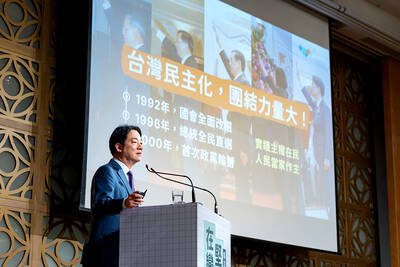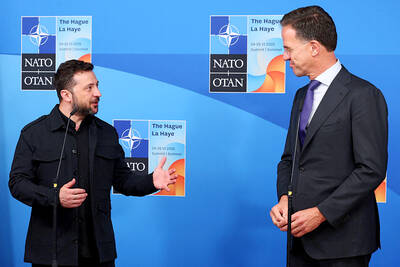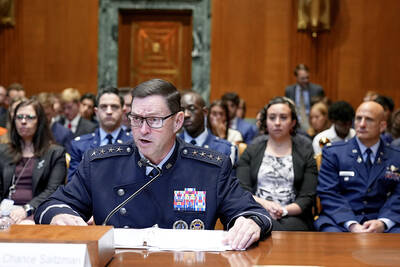The US released a videotape Thursday showing Osama bin Laden laughing and boasting about the Sept. 11 attacks that killed more than 3,000 people.
On the videotape, bin Laden describes how the planes that flew suicide missions into the World Trade Center towers did far more damage than he ever imagined they would. "We calculated in advance the number of casualties from the enemy, who would be killed based on the position of the tower," he said, speaking in Arabic. English subtitles were provided by the US government. "We calculated that the floors that would be hit would be three or four floors. I was the most optimistic of them all."
Bush administration officials said that the amateur videotape, which they believe was filmed on Nov. 9 at a guest house in Kandahar, Afghanistan, was highly incriminating proof that bin Laden was guilty in the Sept. 11 attacks.
Officials said that the tape was found in late November in a house in Jalalabad, Afghanistan, and was subsequently turned over to the CIA. Officials would not say whether the US paid for the tape.
On the tape, bin Laden indicated that the men who carried out the plot knew they were on what he called a "martyrdom operation," but did not have details of the mission until the last minute. "We asked each of them to go to America but they didn't know anything about the operation, not even one letter," bin Laden said. "But they were trained and we did not reveal the operation to them until they are there and just before they boarded the planes."
Bin Laden also said that Mohamed Atta was the leader of the Sept. 11 attacks. "Mohamed from the Egyptian family was in charge of the group," bin Laden said, meaning the al-Qaeda Egyptian group.
The New York Times paper verified the government's translation with two independent Arabic interpreters, who found no significant errors but said that an authoritative translation would require an Arabic transcript. It was impossible to tell from the tape, which jumps among several scenes, if anything was edited out.
The hour-long tape shows a smiling and relaxed bin Laden paying a call on an unidentified man, referred to in the video only as "sheik," who frequently flatters bin Laden about the success of the attacks while they eat and converse. The man, who appears paralyzed from the waist down, also offers bin Laden news and praise from religious figures in Saudi Arabia, which in the videotape emerges as a crucial link to the al-Qaeda terror network.
A senior Saudi official on Thursday night identified the man as a Sheik al-Ghamdi from a tribe in Assir province. The official described him as a militant cleric and said several hijackers were members of that tribe.
The Saudi government moved quickly to condemn bin Laden and others referred to on the tape.
"The tape displays the cruel and inhumane face of a murderous criminal who has no respect for the sanctity of human life or the principles of his faith," said a statement by Prince Bandar bin Sultan, the Saudi ambassador to the US. "Bin Laden and those he mentions in his tape are deviants and renegades who do not represent the Islamic faith or the Saudi people."
The White House made the tape public after nearly a week of intense discussion about its contents and in the end gave the task of its formal release to the Department of Defense. The tape was available at the Pentagon at 11am on Thursday, only an hour after President Bush renounced the 1972 Anti-Ballistic Missile Treaty in a Rose Garden announcement in which he took no questions. The television networks immediately broke into their morning programming to broadcast the tape.
The groundswell for the release began when The Washington Post first disclosed the existence of the tape on Dec. 9, the same day that Vice President Dick Cheney confirmed some of the tape's contents on NBC's Meet the Press.
The tension built throughout the week as the US indicted Zacarias Moussaoui, the first person to be charged as a conspirator in the Sept. 11 plot, and carried out a relentless bombing campaign of the Tora Bora caves in eastern Afghanistan, where bin Laden is thought to be hiding.
Administration officials said that the timing of the tape's release was designed neither to draw attention from the American withdrawal from the ABM Treaty, nor to intensify public opinion against bin Laden as the US attempts to close in on his forces and capture or kill him.
Ari Fleischer, the White House spokesman, indicated on Thursday that the tape was found by people other than Americans at the house in Jalalabad. The Taliban abandoned the city in mid-November. "The manner in which the tape was acquired would suggest that people were leaving the house in a real big hurry and left it behind," he said.
The tape was then turned over to the CIA, which translated it. The president was informed of its existence on Nov. 29, and saw excerpts at the White House during an intelligence briefing on Nov. 30.
Administration officials said that the president wanted to release the tape to the public as soon as he saw it, but with the caveat that it should not compromise intelligence gathering and that the CIA double-check its authenticity.
At that point, officials said, the government asked at least two independent interpreters to help with on another translation of the videotape and compare it to the one done by the US government. Pentagon officials said those interpreters were George Michael of the Diplomatic Language Service and Kassem M. Wahba, the Arabic language program coordinator of the School of Advanced International Studies at Johns Hopkins University. Pentagon officials said the two versions were virtually identical.
The CIA ran a number of tests to determine whether the tape had been altered and to determine whether the voice matched bin Laden's on previous videotapes that he himself had released. In every case, officials said, the matches were identical.
Bin Laden appeared in the tape with Ayman al-Zawahri, his top deputy and the former leader of a faction of the Egyptian Islamic Jihad, and Abu Ghaith, who has been a spokesman for bin Laden.

FREEDOM OF NAVIGATION: The UK would continue to reinforce ties with Taiwan ‘in a wide range of areas’ as a part of a ‘strong unofficial relationship,’ a paper said The UK plans to conduct more freedom of navigation operations in the Taiwan Strait and the South China Sea, British Secretary of State for Foreign, Commonwealth and Development Affairs David Lammy told the British House of Commons on Tuesday. British Member of Parliament Desmond Swayne said that the Royal Navy’s HMS Spey had passed through the Taiwan Strait “in pursuit of vital international freedom of navigation in the South China Sea.” Swayne asked Lammy whether he agreed that it was “proper and lawful” to do so, and if the UK would continue to carry out similar operations. Lammy replied “yes” to both questions. The

SECOND SPEECH: All political parties should work together to defend democracy, protect Taiwan and resist the CCP, despite their differences, the president said President William Lai (賴清德) yesterday discussed how pro-Taiwan and pro-Republic of China (ROC) groups can agree to maintain solidarity on the issue of protecting Taiwan and resisting the Chinese Communist Party (CCP). The talk, delivered last night at Taoyuan’s Hakka Youth Association, was the second in a series of 10 that Lai is scheduled to give across Taiwan. Citing Taiwanese democracy pioneer Chiang Wei-shui’s (蔣渭水) slogan that solidarity brings strength, Lai said it was a call for political parties to find consensus amid disagreements on behalf of bettering the nation. All political parties should work together to defend democracy, protect Taiwan and resist

By refusing to agree spending increases to appease US President Donald Trump, Spanish Prime Minister Pedro Sanchez threatened to derail a summit that NATO Secretary-General Mark Rutte needs to run smoothly for the sake of the military alliance’s future survival. Ahead of yesterday’s gathering in The Hague, Netherlands, things were going off the rails. European officials have expressed irritation at the spoiler role that Sanchez is playing when their No. 1 task is to line up behind a pledge to raise defense spending to 5 percent of GDP. Rutte needed to keep Spain in line while preventing others such as Slovakia

SHIFT PRIORITIES: The US should first help Taiwan respond to actions China is already taking, instead of focusing too heavily on deterring a large-scale invasion, an expert said US Air Force leaders on Thursday voiced concerns about the Chinese People’s Liberation Army’s (PLA) missile capabilities and its development of a “kill web,” and said that the US Department of Defense’s budget request for next year prioritizes bolstering defenses in the Indo-Pacific region due to the increasing threat posed by China. US experts said that a full-scale Chinese invasion of Taiwan is risky and unlikely, with Beijing more likely to pursue coercive tactics such as political warfare or blockades to achieve its goals. Senior air force and US Space Force leaders, including US Secretary of the Air Force Troy Meink and